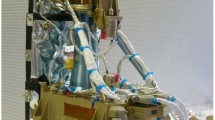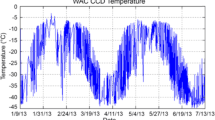Abstract
The Wendelstein Observatory of Ludwig Maximilians University of Munich has recently been upgraded with a modern 2m robotic telescope. One Nasmyth port of the telescope has been equipped with a wide-field corrector which preserves the excellent image quality (<0.8” median seeing) of the site (Hopp et al. 2008) over a field of view of 0.7 degrees diameter. The available field is imaged by an optical imager (WWFI, the Wendelstein Wide Field Imager) built around a customized 2×2 mosaic of 4k×4k 15 μm e2v CCDs from Spectral Instruments. This paper provides an overview of the design and the WWFI’s performance. We summarize the system mechanics (including a structural analysis), the electronics (and its electromagnetic interference (EMI) protection) and the control software. We discuss in detail detector system parameters, i.e. gain and readout noise, quantum efficiency as well as charge transfer efficiency (CTE) and persistent charges. First on sky tests yield overall good predictability of system throughput based on lab measurements.

















Similar content being viewed by others
Notes
Fraunhofer Telescope was built by Kayser-Threde GmbH, Munich and Astelco Systems GmbH, Martinsried
SI900 is a trademark by Spectral Instruments Inc., Tucson, USA
The field flattener was produced by POG Präzisionsoptik Gera GmbH, Germany
The CCDs are a trademark of e2v Inc, Chelmsford, Essex, England
Polycold PCC Compact Cooler is a trademark of Brooks Automation Inc, Chelmsford, USA
I.e. AMiGo, a two channel CCD-camera for the former 80 cm telescope of the Wendelstein Observatory [11].
FLI Microline 3041 is a trademark of Finger Lakes Instrumentation, New York, USA
The linear stages were produced by Franke GmbH, Aalen, Germany
The precision switches were produced by MYCOM AG, Berlin, Germany
See next Section for details on drive logics.
I.e. power supplies, RS232 to Ethernet converters, thermostats, switches, motor controllers, compressor relays, and embedded control PCs.
Armaflex is a trademark of Armacell GmbH, Münster, Germany
LabView is a trademark of National Instruments Corporation, Austin, USA
Pollux Controller and Venus-2 command language are trademarks of PI miCos GmbH, Eschbach, Germany
Moxa NPort is a trademark of Moxa Inc., Brea, USA
Because of this the initialization run has to move “backwards”.
Python Programming Language is a trademark of Python Software Foundation, Beaverton, USA
We used the third row/column next to the border.
We read three overscan regions from each port: Serial pre- and overscan, as well as parallel overscan. The serial overscan displays the smallest and most stable offset to the image region in bias and dark frames.
The filters were manufactured by Omega Optical Inc, Brattleboro, USA
Following the definition by [33].
Exposure times M13: u: 60 s, g: 20 s, r: 10 s, i: 20 s, z: 40 s
Exposure times SA95: u: 60 s, g: 10 s, r: 10 s, i: 10 s, z: 20 s
Exposure times SA97: u: 30 s, g: 10 s, r: 10 s, i: 10 s, z: 10 s
Exposure times PG0918: u: 60 s, g: 30 s, r: 30 s, i: 30 s, z: 30 s
Since we have only a single observation in each filter per airmass, we were not able to calculate the extinction.
g filter: λ=4770 Å,Δλ=1300 Å, i filter: λ=7590 Å,Δλ=1400 Å
References
An, D., Johnson, J.A., Clem, J.L., et al.: ApJS 179, 326 (2008)
Baade, D., Meisenheimer, K., Iwert, O., et al.: Messenger 95, 15 (1999)
Barrick, G.A., Ward, J., Cuillandre, J.-C.: Society of Photo-Optical Instrumentation Engineers (SPIE) Conference Series, vol. 8453 (2012)
Bertin, E., Arnouts, S.: A&AS 117, 393 (1996)
Bindel, A.: Master’s thesis, Ludwig-Maximilians-Universität München (2011)
Buckley, D.R.V., Longmore, A.J.: MNRAS 257, 731 (1992)
Castelli, F., Gratton, R.G., Kurucz, R.L.: A&A 318, 841 (1997)
Cousins, A.W.J.: MmRAS 81, 25 (1976)
Fukugita, M., Ichikawa, T., Gunn, J.E., et al.: AJ 111, 1748 (1996)
Girardi, L., Grebel, E.K., Odenkirchen, M., Chiosi, C.: A&A 422, 205 (2004)
Gössl, C.: PhD thesis, Ludwig-Maximilians-Universität München (2007)
Gössl, C., Bender, R., Fabricius, M., et al.: Society of Photo-Optical Instrumentation Engineers (SPIE) Conference Series, vol. 8446 (2012)
Gössl, C., Bender, R., Grupp, F., et al.: in Society of Photo-Optical Instrumentation Engineers (SPIE) Conference Series, vol. 7735 (2010)
Gruen, D., Seitz, S., Kosyra, R., et al.: ArXiv e-prints (2013)
Hayes, D.S., Latham, D.W.: ApJ 197, 593 (1975)
Hopp, U., Bender, R., Goessl, C., et al.: Society of Photo-Optical Instrumentation Engineers (SPIE) Conference Series, vol. 7016 (2008)
Hopp, U., Bender, R., Grupp, F., et al.: Society of Photo-Optical Instrumentation Engineers (SPIE) Conference Series, vol. 7733 (2010)
Iwert, O, Baade, D, Balestra, A., et al.: Society of Photo-Optical Instrumentation Engineers (SPIE) Conference Series, vol. 6276 (2006)
Janesick, J.: Scientific Charge-Coupled Devices, Spie Press Monograph, Pm83 (Society of Photo Optical) (2001)
Janesick, J., Elliott, T.: Astronomical Society of the Pacific Conference Series, vol. 23, Astronomical CCD Observing and Reduction Techniques, ed. S. B. Howell, 1 (1992)
Johnson, H.L., Morgan, W.W.: ApJ 117, 313 (1953)
Kodric, M., Riffeser, A., Hopp, U., et al.: AJ 145, 106 (2013)
Koppenhoefer, J., Saglia, R.P., Fossati, L., et al.: MNRAS 435, 3133 (2013)
Kormendy, J., Bender, R.: ApJS 198, 2 (2012)
Kurucz, R.: ATLAS9 Stellar Atmosphere Programs and 2 km/s grid. Kurucz CD-ROM No. 13. Cambridge, Mass.: Smithsonian Astrophysical Observatory, 1993., 13 (1993)
Kurucz, R.L.: ApJS 40, 1 (1979)
Landolt, A.U.: AJ 78, 959 (1973)
Landolt, A.U.: AJ 88, 439 (1983)
Landolt, A.U.: AJ 104, 340 (1992)
Landolt, A.U.: AJ 137, 4186 (2009)
Lee, C.-H., Riffeser, A., Koppenhoefer, J., et al.: AJ 143, 89 (2012)
McLean, I.: Electronic Imaging in Astronomy: Detectors and Instrumentation, Springer Praxis Books / Astronomy and Planetary Sciences (Springer) (2008)
Oke, J.B., Gunn, J.E.: ApJ 266, 713 (1983)
Reif, K., Klink, G., Müller, P., Poschmann, H.: Astronomische Nachrichten 326, 666 (2005)
Rhodes, J., Leauthaud, A., Stoughton, C., et al.: PASP 122, 439 (2010)
Schlafly, E.F., Finkbeiner, D.P.: ApJ 737, 103 (2011)
Schlegel, D.J., Finkbeiner, D.P., Davis, M.: ApJ 500, 525 (1998)
Tonry, J.L., Isani, S., Onaka, P.: Bulletin of the American Astronomical Society, vol. 39, American Astronomical Society Meeting Abstracts, 807 (2007)
Acknowledgements
The authors thank Johannes Koppenhoefer and Mihael Kodric for their support with the data reduction process with the WWFI. Furthermore we thank Daniel Gruen for helpful discussions regarding charge transfer efficiency. We also thank Michael Schmidt and Christoph Ries, the night observers at the Wendelstein Observatory for taking the necessary data for our on-sky calibration. Michael Schmidt also took the responsibility for wiring our imager, and we thank him for doing so. We thank Wolfgang Mitsch for giving invaluable advice on configuring the electronics of our camera. We acknowledge the constructive discussion with Dietrich Baade and Olaf Iwert (ESO). This research was supported by the DFG cluster of excellence Origin and Structure of the Universe (www.universe-cluster.de).
Author information
Authors and Affiliations
Corresponding author
Appendix: Charge transfer efficiency in more detail
Appendix: Charge transfer efficiency in more detail
In Section 3.10 we presented the results of the CTI measurement in our laboratory, but we only showed results for one CCD (number 0). In this Appendix we will show the complete set of measurements for all CCDs and compare them to the manufacturer’s results. Figure 18 shows the parallel CTI for all four CCDs compared to the values measured by Spectral Instruments. (USM: red crosses, green, blue and magenta; SI: cyan, yellow, black and red triangles). The plots show overall good agreement between the two measurements with few outliers in CCD1 and CCD2 (top right and bottom left) at low signal levels, where the measurement performed by SI yields higher values than our own results. Figure 19 shows the same for serial CTI. Here we can identify a few more outliers also at low signal levels, but this time SI measures lower values than ourselves. We trust our own measurements more than the SI measurements due to two reasons: First, our measurements are fitted by a power law, while the measurements showing outliers are not, and second, the port-to-port variations of our measurements (without outliers) are much smaller.
The reason why port 2 of CCDs 0 and 2 (green data points in top left and top right of Fig. 19) show a lower CTI by approximately factor of 3 at low signal levels are unknown to the authors.
Rights and permissions
About this article
Cite this article
Kosyra, R., Gössl, C., Hopp, U. et al. The 64 Mpixel wide field imager for the Wendelstein 2m telescope: design and calibration. Exp Astron 38, 213–248 (2014). https://doi.org/10.1007/s10686-014-9414-1
Received:
Accepted:
Published:
Issue Date:
DOI: https://doi.org/10.1007/s10686-014-9414-1






